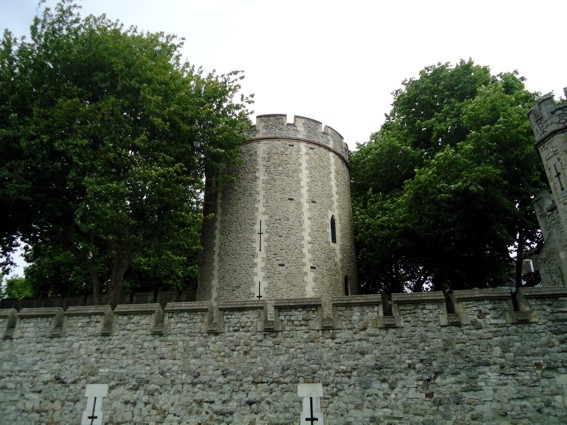
Below the ground where Chandos Street starts to rise sharply after joining West Quay is the foundation of the north eastern corner tower of the castle curtain wall. This was excavated in 1984 by Peter Ellis. The tower was revealed to be of twelve metres diameter and dated to the first half of the 13th century. This, like Place’s section of wall below Castle Street, rested on a strong yellow Ham stone base, built upon the edge of the original river bank. Ellis also noted decorative courses in the sandstone wall of the tower, alternating red and yellow. The tower was found to have projected more towards the east than the north when compared to the walls. The tower was also bonded to the walls, indicating that they were all contemporary.[1]

This discovery supported the documentary evidence of a corner tower, described as being by the river, facing east. Two towers were recorded on the river front, but only one was described specifically as being on the corner, which might imply that the other was not. [2] However, the borough seal depicts two corner towers and it is likely that there was a corresponding tower on the south eastern corner.

Ellis also investigated the north wall, which ran exactly along the northern edge of Chandos Street. The curtain wall here was much less substantial than that of the east. It rested upon very shallow foundations, which did not cut through the natural ground surface. Further to the west the robbed wall was only apparent by a mortar spread. [3] This is not unusual for medieval castles: Michael Thompson asserts that they often had inadequate or no foundations, they were often near the edge of a large ditch and this can help explain collapse over time and why castle walls can be so hard to find in excavations. [4] By the river it was simply necessary for more substantial foundations and tidal defences than elsewhere in the site, which explains the good survival of the east wall, but not any of the others. Ellis also found the southern bank of the northern moat, which contained four graves before the wall foundation. These were presumed to be executed felons buried in un-consecrated ground, attributing to the judicial function of the castle. [5]
[1] Ellis, P., ‘Excavations at Friarn Street and West Quay, Bridgwater, 1983/84’ in SANHS (vol 129, 1985) pp. 76-77
[2] Dilks, T. B., ‘Bridgwater Castle and Demesne towards the end of the fourteenth century’ in SANHS (vol. 86, 1940) p. 101
[3]Ellis, ‘Friarn Street and West Quay, 1984’ pp. 76-77
[4] Thompson, M. W., The Decline of the Castle (Cambridge University Press, Cambridge, 1987) p. 14
[5] Ellis, ‘Friarn Street and West Quay, 1984’ p. 77
